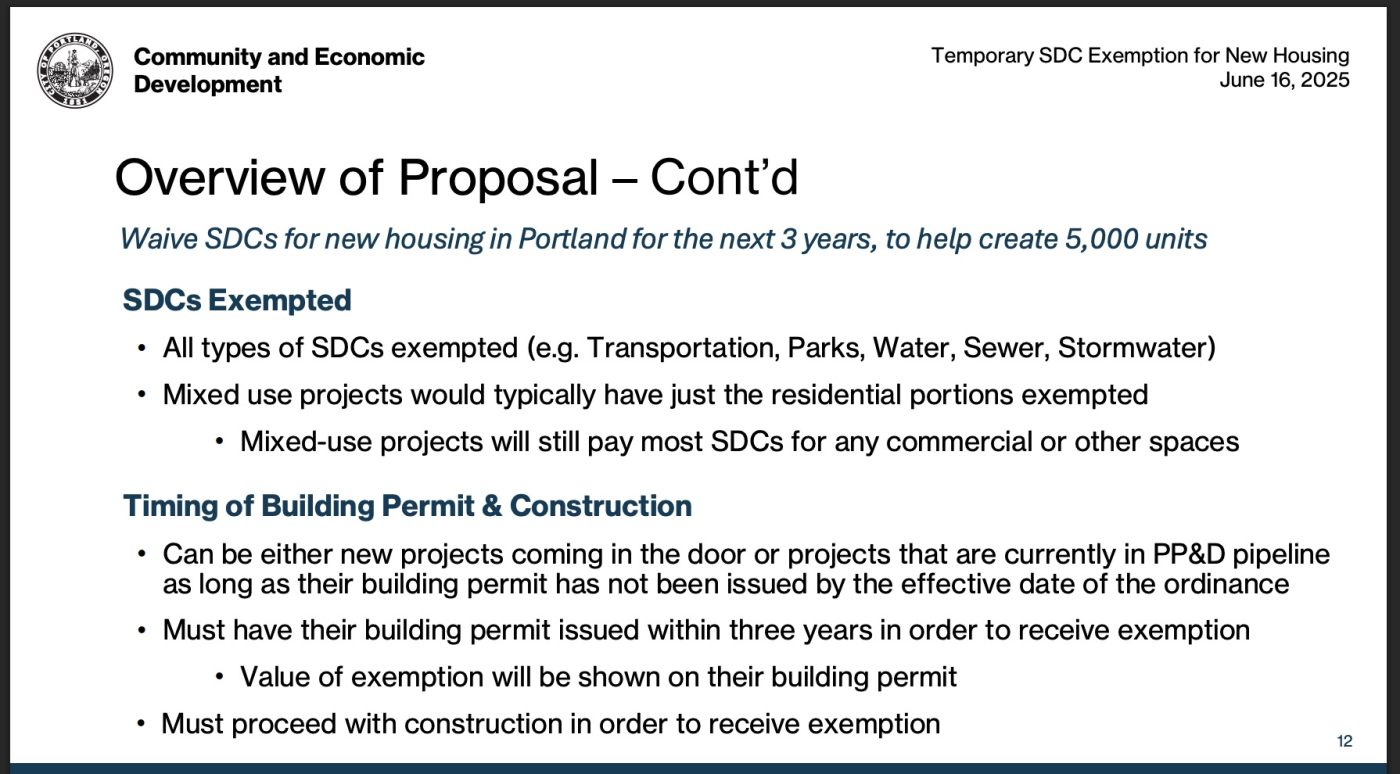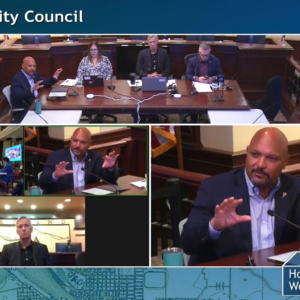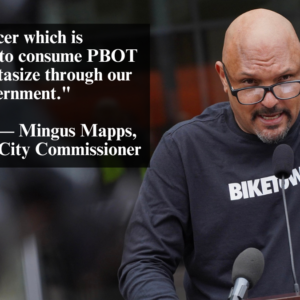
Last week Portland City Council voted unanimously to give developers a three-year reprieve from paying system development charges (SDCs) on residential housing projects. SDCs are fees paid to city bureaus to help pay for infrastructure that supports new developments.
While councilors agreed the fee waiver would help boost badly needed construction of more residential units (Portland produced just 818 market rate units in 2024, the lowest total in 10 years), it’s worth noting that the move represents yet another loss of funding for the Portland Bureau of Transportation (PBOT). The three-year SDC moratorium is estimated to cost the City of Portland about $63 million total.
According to a presentation from the Office of Community and Economic Development shared with City Council, the move will cost PBOT $10 million. This comes on top of a narrowly averted budget crisis, continued uncertainty with federal funding that has put $197 million in project grants in limbo, and an $11 million gap from the state due to the failure of HB 2025.
While 10 councilors (two were absent) voted to support the fee waiver ordinance with hopes it would boost production of 2,500 additional housing units (on top of estimated 2,500 for a total of 5,000), some expressed reservations.
“I’m worried about how much infrastructure funding where we can afford to lose,” said Councilor Candace Avalos, who represents east Portland.
Council President Elana Pirtle Guiney said, “I don’t take lightly the fact that we’re foregoing tens of millions of dollars of revenue for public infrastructure at a time when we have so many infrastructure needs. But I also know that right now, with the tools in our toolbox, this is the single most impactful thing that we can do this year to support housing development.”
The loudest and most eloquent supporter of the SDC waiver is District 4 Councilor Mitch Green. He told members of the PBOT’s Pedestrian Advisory Committee last week that he simply doesn’t like SDCs.
“Because however well-intentioned they are,” Green explained, “They only work when there’s development occurring and they are a marginal cost of development.” Green feels it’s already relatively expensive to develop land in Portland due to our labor and land-use laws, so anything that increases the cost of production just leads to less housing being built. “And if you get less of it, you don’t get as much of a resource for your infrastructure development, which means that latest development, or that last part of the city to come into the boundaries of the city just doesn’t get it, and then you have to compete for a small pool of money relative to the scale of the problem.”



Green sees infrastructure as a “collective problem” and a “public good that spans the whole city,” whereas SDCs only accrue in parts of the city lucky enough to see development. “The unintended consequence of it is you have a situation where neighborhoods have been brought into the city and just haven’t seen any infrastructure development on any meaningful time scale… if you have a family that moves to Hayhurst (in southwest), for instance, their kids are going to grow up and move away before they’re going to get a sidewalk to school. And that’s because we don’t have enough money in the bank for SDCs.”
Key to Green’s outlook on SDCs is that more housing units equals more taxpayers who can ultimately pay into a future PBOT funding pot. Green would rather see a more stable funding source for PBOT and he mentioned several times the city’s current effort to find one.
The ordinance that passed yesterday has set a goal of 5,000 housing units in the next three years. Expect City Council to monitor progress toward that goal and discuss the future of SDCs when — or if — it’s reached.






Thanks for reading.
BikePortland has served this community with independent community journalism since 2005. We rely on subscriptions from readers like you to survive. Your financial support is vital in keeping this valuable resource alive and well.
Please subscribe today to strengthen and expand our work.
Few questions:
Lyndon, I realize this has nothing to do with IZ, but the developers I know say that the IZ is what is limiting development of new housing, not SDCs. What is your take on that.
To go one step further, why is the City one limitation to building housing SDCs) and not others (IZ)
Hi there – housing land use expert here. I can speak to your questions
1. Nothing in the proposal changes the city’s current inclusionary housing policy to my knowledge.
2. It might have a potential effect but that disincentive actually exists right now. The mixed use buildings we have seen over the last decade or so (ie wood framed apartments above a concrete commercial podium) basically don’t financially pencil in the current market because of their higher costs and softer retail and rental demand. Maybe this provision will further incentivize residential only, though maybe not! It’s hard to say for certain.
3. I am not aware of a city specific analysis, but the state completed a pretty comprehensive analysis of SDCs a couple of years back. The takeaway: SDCs are an important source of revenue for cities but are charged in a manner that’s regressive and disincentivizes smaller, less expensive housing. Here’s the link! https://www.oregonlegislature.gov/citizen_engagement/Reports/Oregon%20SDC%20Study_FinalReport_121522.pdf
Thanks Lyndon and Sean. Very helpful!
Are they going to pause the inclusionary zoning requirements, too?
IMO it’s not true that this will cost PBOT $10M. That’s how much SDC revenue they’ll lose out on given we remove the fees & developers actually start building again. 10% of 0 is 0. If nobody’s developing, PBOT doesn’t get any SDC revenue either.
It was news to me that they have had a 2 year zero interest delayed SDC payment program in place since 2023, which would ostensibly allow for a project to be stabilized before SDC’s are due, and that has had no impact to the pace of development.
Ain’t nobody gonna be investing in new developments in Portland while Dump is doing his best to screw up the economy, sending the military to occupy blue cities, and we have more houses for sale than buyers. It has nothing to do with fees, they would willingly pay the fee and start building tomorrow if they thought there was a good return on investment
Funny, I saw new apartment buildings and single family homes under construction in Bend recently so obviously there are much friendlier places than Portland that developers are making money building.
Funny, I saw new apartment buildings and single family homes under construction in Portland recently so obviously that is a friendly place for developers to make money building.
Could someone please explain how this move is going to increase sidewalk coverage in Southwest Portland? I don’t see the connection.
I took Mitch Green’s comment about sidewalks as an example of how SDCs are not solving known infrastructure problems in areas that don’t have much development to generate the charges for system development. SDCs are justified as offset the extra load on the city infrastructure caused by the development, not to correct past decisions to develop some neighborhoods with infrastructure that prioritizes cars, as much of southwest seems to have been developed.
That said, my question is this: Without the SDCs, how does Mitch or the rest of the unanimous council propose the city pay for the necessary system improvements to support the 5000 additional residences?
I think there’s some magical thinking going on along the lines of: SDCs are an imperfect funding tool so it’s OK to get rid of them and replace it with [unspecified something else later]. To me half of what is disappointing here is that Council doesn’t have the sophistication to use this to leverage that [unspecified something else later]. What could it have looked like to try passing a new local funding stream and getting the home builder lobby on board if it replaced SDCs? Instead, they are throwing out a revenue stream we have with no real plan, hoping to be bailed out later. As if voters are going to love voting for more transportation revenue /after/ they read the inevitable Willamette Week article we’ll see in a year scandalized about how much some easy-to-dunk-on luxury development isn’t paying. Meanwhile, no one is doing anything about land costs. Land owners pay attention to these giveaways too and want their cut.
Waiving SDCs makes absolutely no sense and is nothing more than a knee-jerk reaction to the problem of affordable housing. It will in fact result in less investment in active transportation.
SDCs are in fact an essential tool in the management of public infrastructure. SDCs exist to generate revenue for the lost capacity of infrastructure that results from growth so that it can be expanded to accommodate more growth in the future. By waiving SDC’s, Portland will have to rely upon existing rate payers to pay the cost of added capacity as the City grows in the future.
How absurd for Green to mentioned that SDCs are not the solution to infrastructure funding. They are the solution to providing the capacity needed to accommodate growth, not a solution for existing infrastructure deficiencies. If a City does not grow, they do not need the revenue from SDCs because they do not need more capacity.
By waiving SDCs, existing homeowners are subsidizing the cost of growth. It is that simple. I doubt that the majority of Portland’s citizenry support subsidizing growth, but perhaps they do.
The way PBOT (in reality City Council) has used transportation SDC funding over the last 30 years has been problematic. The vast majority was used to subsidize downtown projects, more than double what downtown generated in SDC funding – nearly every neighborhood in the city ended up “subsidizing” downtown development with the exception of inner NE which broke even (it took in roughly the same SDC funding as it generated.) In most years, there was always a huge surplus in SDC funds sitting in the bank, even when PBOT was making vast cuts in budgets and personnel, because the city can only use the funds for certain previously-listed projects (the list is reviewed every 10 years), and only those that add capacity, based on state rules. It’s neither a stable funding source nor very flexible – I can fully understand Mitch Green’s frustration with it – but PBOT doesn’t have any good alternatives that are both stable and that City Council can’t grab with their sticky fingers to use elsewhere. The ULF was supposed to be that ideal funding source (for repairing cut-up streets), but less than 5% now goes to PBOT; gas tax and parking revenue continue to shrink; vehicle registration is poorly enforced; federal grants are incredibly political; and the state…
It WOULD be that simple if the SDCs charged to a project accurately reflected the impacts of that project, but they often don’t. Plus, the SDC fees a project pays often don’t go towards mitigating the impacts of that project.
I’m not saying SDCs are bad, or that they could ever be adjusted to be perfectly fair or accurate in regard to paying for mitigating impacts of each project.
But it’s not that simple, even without getting into the negative impacts of SDCs.
Hate to say it, but Mitch is spot on. SDC’s are estimated to be $20k per unit on average, a traditional 4 or 5 story stick built apartment building on a concrete podium runs between $350k-$500k per unit in all-in costs here in Portland (assuming close in infill location). A marginal 4-6% reduction in cost does not move the needle for a new project to move forward and certainly should not be used as the assumption that it will somehow double the number of units expected to be built in the next three years. Until interest rates materially improve (not going to happen without major softness in the economy), lending gets a lot easier (not going to happen because lenders are seeing massive losses from deals done in 2021-2023) or the cost of equity goes down dramatically (unlikely without economic softness) development is likely to be very slow especially when developers bake in to their analysis that Portland has some of the most tenant friendly rental laws in the nation, it just makes sense to allocate effort and capital elsewhere.
Mitch Green gets it. The City (and PBOT in particular) hasn’t had a sustainable revenue strategy for decades. Their cobbled budget largely consists of misappropriated taxes and poorly aligned fees, and the overall revenue picture is one of decline and decrepitude.
Of course removing SDCs will have adverse affects on transportation unless it is matched with new sources of revenue (and/or cost savings). This is going to be a much bigger political lift, but it is refreshing to at least be starting from a clear-eyed assessment of the problem. In the meantime, let’s hope this at least helps jump-start housing development.
“Mitch Green gets it.”
If Mitch Green thinks that SDC fees are why developers aren’t building in Portland, he does not get it.
If Mitch Green wants to be seen as doing something, no matter how ineffective, to increase housing in Portland, then he gets it.
If your read his quotes in the article, it’s clear he does NOT believe that, and it’s not why he pushed to waive them.
I’m not so sure:
I can’t read his mind, but it seems that Green was motivated by a desire to increase housing production. If this was just a “SDCs are inefficient” play, then he picked a very bad moment financially to cut another reliable revenue stream from PBOT and other struggling bureaus.
Yes, he’s saying in that quote that SDC fees are only one of several cost issues developers have to deal with.
SDCs have always had some dubious logic behind them, especially when applied to urban projects.and infill.
It’s hard to argue that a new subdivision or shopping center built on farmland won’t place new demands on roads, schools, parks, sewers, etc. so should be required to pay something for upgrades to offset the new impacts.
It’s murkier to say that an in-city, infill housing project should pay, when the project may only be bringing density back to levels it was when the original infrastructure (that’s still there) was built. The new housing there may even have positive impacts on transportation infrastructure just by virtue of it being built there.
I’m not anti-SDCs, just saying if any type of project is going to be exempted from them, you could do a lot worse than to choose urban infill housing projects.
This is a really great point qqq. On the surface building traditional infrastructure to a new low-density suburb is extremely expensive, and can only pencil out in the very short run if the city is paying for it through an already existing tax base coming from the dense urban core, as well as subsidizing it through federal bonds/grants for highways. Without that subsidizing from the feds, almost no suburb would be financially solvent.
Since much of that infra is already existing within inner-city infill, it’s presumably a bigger ROI for the city. But it really depends on what the money goes towards. Since large transportation projects are funded at about 25% local and the rest federal/state, and the long term ROI on a highway vs a subway is vastly different. The water gets muddy. There’s no question, for example, the IRQ project is currently insolvent. But it’s also a terrible long term investment. SDCS aren’t funding maintenance, and in a car-heavy culture, that’s bad news.